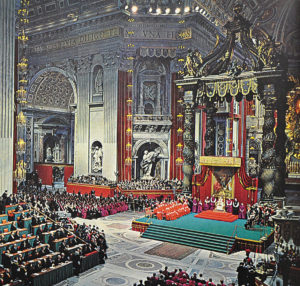Extraordinary is Ordinary
The Rev. John A.H. Tomoso†
In the Church (Liturgical) Year, the current season of prayer and praise is called Ordinary Time. Now, one can certainly argue the point that any time spent with God is “extraordinary.” Nonetheless, Ordinary Time comprises two periods of time in the Christian Liturgical Year that are found in the Liturgical and Sanctoral Calendar of the Roman Catholic Church and other churches of Western Christianity, including those that use the Revised Common Lectionary namely the: Anglican (Episcopal Church) Communion, Methodist churches, Lutheran churches, Old Catholic churches and Reformed churches. In Latin, the name of this time is Tempus Per Annum, translated as “time during the year.” Those believers, like me, who keep the cycle of Sunday and Daily Prayer, including the celebration of the Eucharist, probably have wondered about this phrase Ordinary Time and why we are to understand its significance in the life of the Church and the People of God, who offer prayer and praise to God, day in and day out.

Specifically, Ordinary Time comprises two periods: the first period begins on Epiphany Day (in the Anglican (Episcopal Church) Communion and Methodist churches) or the day after the Feast of the Baptism of the Lord (in the Catholic Church) and ends on the day before Ash Wednesday. The second period begins on the Monday after Pentecost which is the conclusion of the Easter season and continues until the Saturday before the First Sunday of Advent. Both of these periods of time combined are the longest time in the liturgical year which is probably familiar to most Christians. Thus, probably without knowing it, many folks in their life of faith are offering “ordinary” prayer and praise to Almighty God.
Throughout the ages, the Church has always divided the year into seasons during which specific aspects of the mysteries of Christ’s life are celebrated. For the sake of understanding, let me state that before the convening of the Second Vatican Council, the Church began its Liturgical Year with Advent, beginning on the fourth Sunday before Christmas and running through Christmas Eve. The season of Christmas was next, running through the Epiphany (January 6). The next major season was Lent, from Ash Wednesday (the seventh Wednesday before Easter) until the day before Easter; then the Easter season itself, running through Pentecost, the seventh Sunday after Easter. The two remaining stretches of the year (six weeks or so after Epiphany and twenty-seven or so after Pentecost) were referred to as the Sundays after Epiphany (or Pentecost): thus, the Second Sunday after Epiphany or the Eighteenth Sunday after Pentecost.

Consequently, in 1969, the Vatican issued the Universal Norms on the Liturgical Year and the Roman Calendar which discussed in detail the changes to be made. One of these was the introduction of the season of Ordinary Time which replaced what had been the Sundays after Epiphany and the Sundays after Pentecost. This document defines Ordinary Time in this way: “It begins on the Monday which follows the Sunday occurring after January 6th and extends up to and including the Tuesday before the beginning of Lent. It begins again on the Monday after Pentecost Sunday and ends at Evening Prayer of the First Sunday of Advent.”
As far as I can determine, from print and online sources, Ordinary Time is derived from the word ordinal, meaning “numbered,” since the Sundays (and weekdays) are ordered numerically. Etymological sources suggest that Ordinary Time is related to our word ordinary, which connotes the sense and experience of time and order, derived from the Latin word ordo. Going deeper etymologically, other connotations include the sense and experience of “ordinary,” “common” or “usual.” Thus, Ordinary Time can mean “common or usual time.” So, going back to the beginning of my column and my sincere belief that all time with God, in prayer, in praise, in action, in believing, is “extraordinary,” I would like to leave you all with a wish, “Have an extraordinary time in and with God, in your daily and ordinary lives!”
 Rev. John A. Hau’oli Tomoso† is a Social Worker and Episcopal Priest. He is a Priest Associate at Good Shepherd Episcopal Church in Wailuku and an on-call Chaplain at Maui Memorial Medical Center. Tomoso was graduated from St. Anthony Jr./Sr. High School, the College of St. Thomas in St. Paul, Minnesota (Bachelor of Arts in Political Science and Sociology) and Myron B. Thompson School of Social Work at the University of Hawai’i at Mānoa (Masters of Social Work). In 2008, he retired from the civil service as the Maui County Executive on Aging. In March 2019, Tomoso retired as the Executive Director of the non-profit Tri-Isle Resource Conservation and Development Council, Inc., after a social work career that spanned 43 years of practice. His wife Susan recently retired as a 7th grade Language Arts Teacher at Maui Waena Intermediate School.
Rev. John A. Hau’oli Tomoso† is a Social Worker and Episcopal Priest. He is a Priest Associate at Good Shepherd Episcopal Church in Wailuku and an on-call Chaplain at Maui Memorial Medical Center. Tomoso was graduated from St. Anthony Jr./Sr. High School, the College of St. Thomas in St. Paul, Minnesota (Bachelor of Arts in Political Science and Sociology) and Myron B. Thompson School of Social Work at the University of Hawai’i at Mānoa (Masters of Social Work). In 2008, he retired from the civil service as the Maui County Executive on Aging. In March 2019, Tomoso retired as the Executive Director of the non-profit Tri-Isle Resource Conservation and Development Council, Inc., after a social work career that spanned 43 years of practice. His wife Susan recently retired as a 7th grade Language Arts Teacher at Maui Waena Intermediate School.
